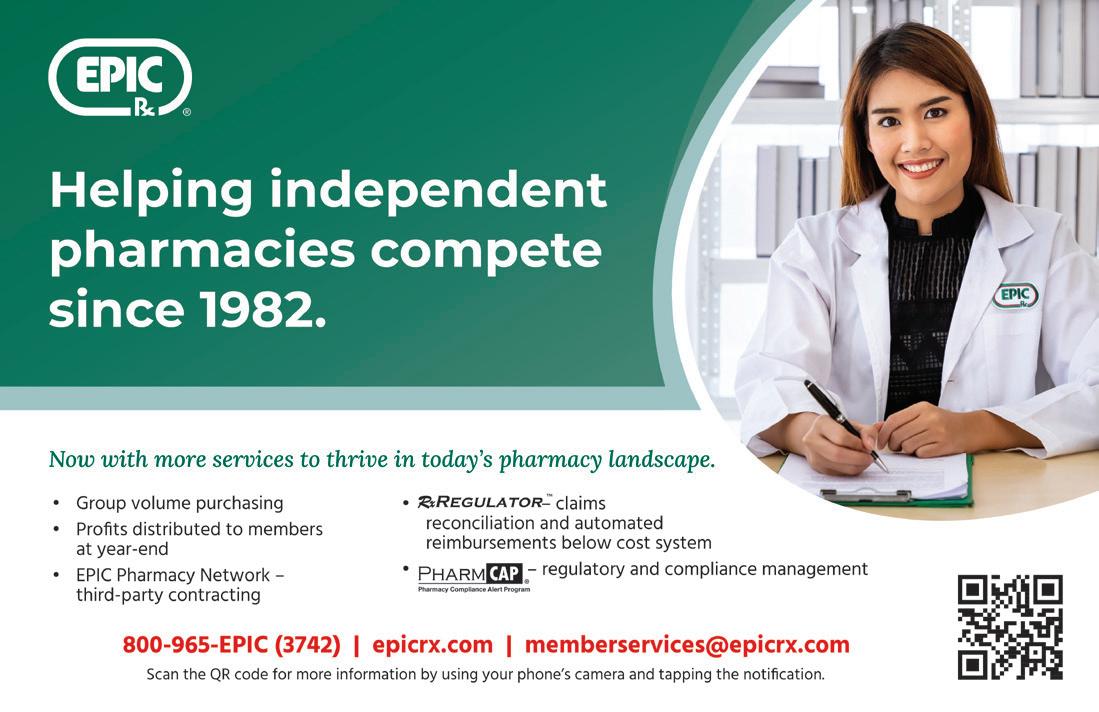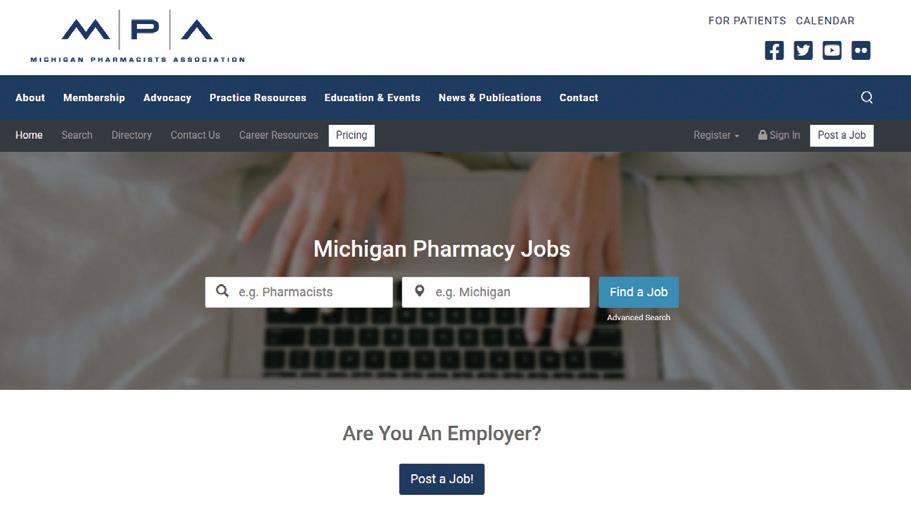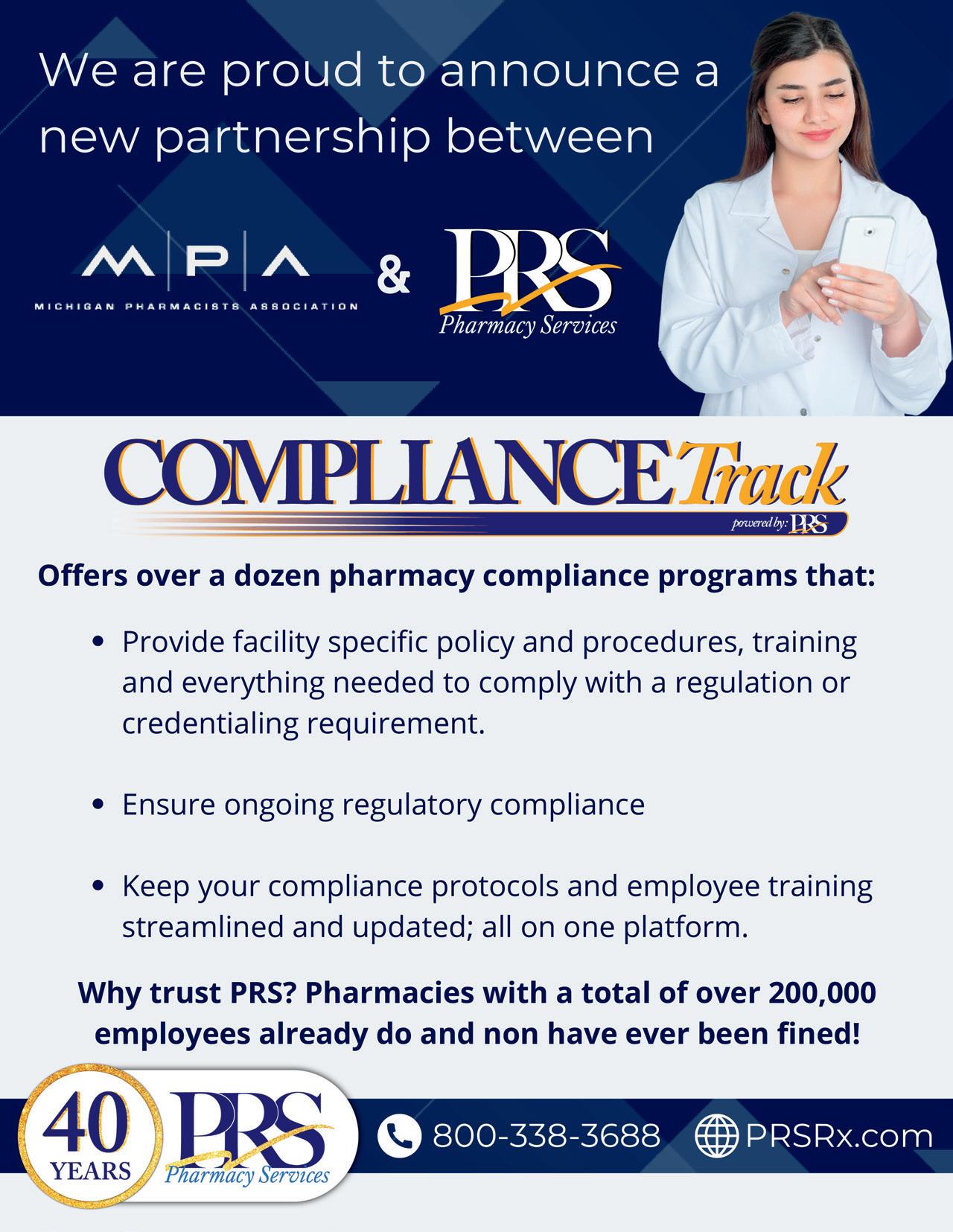
18 minute read
Drug Update
NEW & NOTABLE
NOVEL MEDICATIONS WORTH KNOWING
BY FARAH JALLOUL,
director of professional development, Michigan Pharmacists Association; JACKSON MAURER,
P4 student pharmacist, Ferris State University; and
JASON CORMIER, P4
student pharmacist, Wayne State University
Novel Medications for Type 2 Diabetes
Just as Michigan was starting to warm up for summer this year, a novel injectable medication by Eli Lilly and Company, Mounjaro™ (tirzepatide) entered the world of medicine. Mounjaro™ received approval from the U.S. Food & Drug Administration (FDA) for adjunct treatment of patients with type 2 diabetes with concurrent diet and exercise, becoming the first and only medication of its kind in regard to its mechanism of action. Unlike all previous diabetic injection therapies, Mounjaro™ has a dual mechanism of action acting on both glucosedependent insulinotropic polypeptide (GIP) and glucagonlike peptide-1 (GLP-1) receptor agonism. Once-weekly injections, established auto-injector pens and a pre-attached hidden needle device are a few of the advantages of this dual-acting agent. Mounjaro™ markets therapeutic maintenance doses of 5 mg, 10 mg and 15 mg with 2.5 mg increments available for titration purposes. In a study, patients in the approval-based SURPASS program had a decrease in A1C of 1.8 percent to 2.1 percent with the 5 mg dose and 1.8 percent to 2.4 percent with both 10 mg and 15 mg maintenance doses. These were superior to all comparators in the trials including weekly semaglutide. Mounjaro™ is not currently indicated for weight loss; however, it was an endpoint throughout the SURPASS program with patients receiving treatment losing between 12 to 25 pounds on average. Weight loss is significant for this patient population, as 90 percent of patients are overweight and 60 percent are obese. This weight loss is one of the benefits leading to proposed healthcare savings for patients, as well as the theorized possibility of improving other concurrent disease states.
The side effect profile of Mounjaro™ mirrors that of its GLP-1 injection counterparts, being low incidents of hypoglycemia. The highest reported side effects were nausea, diarrhea and other gastrointestinal distress. Mounjaro™ is not indicated for use in patients with type 1 diabetes, history of pancreatitis, and it does carry a black box warning of thyroid C-cell tumors. When a new brand of medication enters the market, one of the first questions asked, by both healthcare professionals and patients alike, is what the cost will be, especially on the patient end? The manufacturer of the medication is providing patient assistance; for those who qualify, patients will have a $25 copay, lasting for the first year of treatment using Mounjaro™. For more information on cost savings options please visit www.Mounjaro.com. Further information on coverage and accepted plans will come with time.
A New Addition to Weight Loss Therapy
In June 2021, Wegovy® (semaglutide) became the first drug in over a decade to receive an FDA approval for chronic weight loss management. Wegovy® is now one of only five medications approved for this indication. This approval comes in the midst of the ongoing COVID-19 epidemic, with studies tying obesity to overall worse health outcomes in COVID-19 patients, including higher rates of hospitalization, higher risk of being placed on ventilation and increased mortality. The Semaglutide Treatment Effect in People with Obesity (STEP) program, a 68-week trial, showed a 14.9 percent decrease in patient mean body weight on Wegovy® – a marked improvement over a shorter 56-week trial (SCALE 2015) that itself showed an 8 percent decrease in mean body weight. Wegovy® boasts a weekly injection schedule, as compared to the daily administration of similar product Saxenda®; both have similar common side effects and titration schedules that mirror one another in purpose and duration. Weekly dosing of Wegovy® for this indication, 2.4 mg, exceeds the maximum recommended dose for semaglutide’s other indication, treatment of type-2 diabetes mellitus (2.0 mg). Following this data, Wegovy® appears to be a good option for the patient populations included in the study, with fewer injections, similar side effects, and greater efficacy than Saxenda.® The downside to new medications is always cost, and Wegovy® is no exception. However, patient assistance programs exist from the manufacturer for those who qualify.
NEW with Norliqva®
Norliqva® 1 mg/mL is the first FDA-approved liquid solution of amlodipine indicated for the treatment of hypertension and coronary artery disease in adults. It is indicated for the treatment of hypertension in children 6 years of age and older to lower blood pressure; it is kidfriendly, with a mild peppermint flavor. Adult recommended starting dose: 5 mg orally once daily with a maximum of 10 mg orally once daily. Small, fragile or elderly patients, or patients with hepatic insufficiency, may be started on 2.5 mg orally once daily. Pediatric starting dose: 2.5 mg to 5 mg orally once daily. To learn more about Norliqva, visit: www.Norliqva.com. Patients may qualify for the EasyPay Copay program, visit: www.CMPPharma.com/EasyPay for more information.
In addition to vaccination and isolation procedures to combat COVID-19, providers can also recommend oral antiviral agents to COVID-positive patients to lessen the duration and severity of infection. Paxlovid™ was granted emergency use authorization (EUA) by the FDA in December 2021. Since then, millions of treatment kits have made their way across the United States and into the hands of participating pharmacists. Paxlovid™ is a Pfizer®-designed oral drug consisting of tablets of nirmatrelvir (a peptidomimetic inhibitor of the SARS-Cov-2 main protease that prevents viral replication by inhibiting processing of polyprotein precursors) and ritonavir (an antiviral given to reduce metabolism of nirmatrelvir in the liver). It is packaged as daily blister cards; each card containing six tablets (four x 150 mg pink tablets of nirmatrelvir and two x 100 mg white tablets of ritonavir). Three tablets (two nirmatrelvir and one ritonavir) are taken twice daily for a total of five days.
On April 14, 2022, the FDA expanded its EUA to include a new package with doses appropriate in patients with moderate renal impairment. These packages consist of dose cards with four tablets (two x 150 mg pink tablets of nirmatrelvir and two x 100 mg white tablets of ritonavir). Two tablets (one nirmatrelvir and one ritonavir) are taken twice daily for a total of five days. So, who should receive Paxlovid™? According to the EUA, patients who: • have at least mild-to-moderate COVID-19, with a positive test within five days of symptom onset. • are over 12 years of age. • weigh at least 40 kg (88 lbs). • are at high risk for progression to severe COVID-19, including hospitalization or death. Under the EUA, the FDA has specifically elucidated that it should NOT be used: • for initiation of treatment in patients requiring hospitalization due to severe or critical COVID-19. • for pre-exposure or post-exposure prophylaxis for prevention of COVID-19.

• for longer than five consecutive days. Paxlovid™ is contraindicated in patients taking certain CYP3A4 substrates and potent inducers which includes certain antiarrhythmics, immunosuppressants, anticonvulsants and anticancer medications.
Pharmacists Authorized to Prescribe
Most recently, pharmacists have gained prescribing authority under the EUA, with some regulations. Michigan pharmacists can prescribe Paxlovid without delegation from a physician as long as adequate medical documentation to evaluate the patient’s renal and hepatic function is established, as well as information to gauge the risk for potential drug interactions as defined in the EUA. According to the updated FDA EUA fact sheet, Paxlovid can be prescribed by a pharmacist under the following conditions: • Sufficient information is available, such as through access to health records less than 12 months old or consultation with a healthcare provider in an established provider-patient relationship with the individual patient, to assess renal and hepatic function; and
• Sufficient information is available, such as through access to health records, patient reporting of medical history, or consultation with a healthcare provider in an established provider-patient relationship with the individual patient, to obtain a comprehensive list of medications (prescribed and non-prescribed) that the patient is taking to assess for potential drug interaction. • Pharmacists should refer patients for clinical evaluation (i.e., telehealth, in-person visit) with a physician, advanced practice registered nurse or physician assistant, if any of the following scenarios apply: • Sufficient information is not available to assess renal and hepatic function. • Sufficient information is not available to assess for a potential drug interaction. • Modification of other medications is needed due to a potential drug interaction. • PAXLOVID is not an appropriate therapeutic option based on the authorized Fact Sheet for Healthcare Providers or due to potential drug interactions for which recommended monitoring would not be feasible. MPA continues to fight to ensure patient access to important medical care by removing red tape and empowering our pharmacists with testto-treat authority. The situation is continually developing – the MPA will continue to provide updated information to membership. References available upon request
Protect Your Income, PROTECT YOUR FAMILY

Illness or Injury? Disability Insurance Has You Covered
BY RON DEVERS,
CIC, CPIA, director of operations, PSI Insurance Agency One in four of today’s 20-year-olds can expect to be out of work for at least a year because of a disabling condition before they reach the normal retirement age, according to the Social Security Administration. It’s no wonder that medically related work loss continues to be a leading contributor to bankruptcy. While it’s standard to insure our homes, cars, toys, businesses, etc., many people neglect to insure their largest asset—their ability to work and earn a living. What is disability insurance? Disability insurance provides a person with a portion of their income if an illness or injury prevents them from working. The cost depends on several factors, but, typically, it is approximately 1-3 percent of a person’s annual salary. The most common reasons for short- and long-term disability claims include musculoskeletal disorders, pregnancies and cancer. Some common myths exist regarding disability insurance. One myth is that people don’t need it, because they are covered by workers’ compensation. While workers’ compensation insurance is important and required in most cases, according to the Michigan Workers Compensation Act, it only covers work-related injury and illness. If the injury or illness occurs outside of the workplace, workers’ compensation would provide no coverage. Additionally, many business owners exclude themselves from workers compensation, as they legally can do, emphasizing the importance for business owners to carry disability insurance. Unfortunately, I know of several pharmacists who regrettably had to sell their business due to an injury or illness that prevented them from running their business. They could not afford to collect a paycheck for themselves and pay a replacement pharmacist. Another myth is if a person is young and healthy, they don’t need disability insurance. But no one knows what the next minute holds, and tragically, accidents happen to healthy people all the time. Many people become afflicted with a variety of health conditions that can have long-lasting effects on their ability to provide for their households. Statistically, 375,000 Americans become disabled every year, and approximately 110 million Americans don’t have long-term disability insurance. The truth of the matter is that in the course of their career, a person is 3.5 times more likely to be injured and need disability insurance coverage than they are to die and need life insurance, according to the Health Industry Association of America. A 35-year-old has a 48 percent chance of suffering a disability that lasts longer than 90 days before age 65. The average length of said disability is 4.7 years. At age 50, the chance drops to 34 percent, but the length of disability increases by 1.5 years, according to the National Safety Council. Don’t be a statistic. Call PSI Insurance Agency, and let’s talk about this and other ways to protect your family. We’re in business to protect your business and family.

TripPlanet welcomes MPA members by giving them access to deeply discounted airfare and hotel rates through a private, invite-only platform



LOCAL ASSOCIATION SPOTLIGHT:
WAYNE COUNTY PHARMACISTS ASSOCIATION
BY SARAH HILL, president-elect, WCPA and DAN LOBB, president, WCPA

Jessica Efta, then-WCPA president, center left, presents a check to Rev. Frank Julian, head of Fighting Aids with Nutrition (FAWN), at Comerica at the 2017 WCPA Detroit Tiger fundraiser to benefit FAWN. Joining them are students from Wayne State University, WCPA Board members and FAWN Executive Board members.

Ashley Blanchette, Macomb County Pharmacists Association president, joins WCPA in its annual Putt-Putt for PAC/Al Tendler Invitational in 2019.

WCPA Chairman Dan Lobb sizes up the competition at WCPA’s annual Feather Bowling competition celebrating National Pharmacy Week in October 2019.
What activities does your local organize and conduct?
The Wayne County Pharmacists Association (WCPA) has several annual events that we host each year. In the early summer, we organize a social baseball outing to raise funds for Fighting Aids with Nutrition (FAWN), we hold Putt-Putt for PAC in the late summer to raise funds for the Pharmacy Political Action Committee (PAC), and we do a fun night of Feather Bowling at Cadieux Café in Detroit to celebrate National Pharmacy Week in October. Other activities vary slightly by the year but have included many health fairs, a student law review, meetings with local representatives, participating in a fun run/walk, educational programming, movies at the Redford theater and more! We try to provide our members with a mix of social events, advocacy opportunities and educational programming.

What is an example of an innovative event or initiative that your local has recently been engaged in and how did it have a positive impact?
I don’t feel like we’ve done anything new since COVID-19! However, we resumed our annual baseball game raising funds to benefit FAWN on June 25!
How would someone get involved in your local if they were interested? How could they express interest in serving on the WCPA Board of Directors?
WCPA holds regular meetings the third Tuesday of the month at 7:30 p.m., 11 months of the year (we do not have an official meeting in December, though usually we meet to discuss resolutions for the Michigan Pharmacists Association House of Delegates). Our meetings are hybrid and are held via zoom and in-person at Henry Ford Community College in the Ghafari meeting room. Zoom links are sent out prior to our meetings and are a great way to join the meetings, especially if you are joining from a distance. We have several board members who virtually commute to our meetings from over an hour away. To be added to our email mailing list, please email WCPA President Dan Lobb at Gandalf480@aol.com. The address for our in-person meeting space is: 5101 Evergreen Road, Dearborn, 48128. If you are attending in person, please be aware that we follow Centers for Disease Control & Prevention (CDC) guidelines for in-person meetings. We practice social distancing and ask that each participant bring a computer or phone so that they can use a personal video to help facilitate the hybrid format. Like our page on Facebook for more updates and event announcements!
What is one thing that you would like student pharmacists and pharmacy professionals who are not involved in their local to know?
WCPA has a proud history of welcoming student pharmacists and young practitioners to all our meetings. In fact, there is a designated voting board member position held specifically for student pharmacists. For the past several years, we have had a student liaison from the University of Michigan, in addition to our traditional Wayne State University student liaison. WCPA also has a designated board position for a pharmacy technician. We would love to have more pharmacy technicians involved in our association! Wayne County Pharmacists Association is home to pharmacy professionals from all practice sections of pharmacy. We pride ourselves in the diversity of practice sections represented on our board. We are always looking for pharmacy professionals to serve on our board, committees and to work with us on our service projects throughout the year!
LOCAL MEETINGS AND EVENTS
Capital Area Pharmacists Association (CAPA)
Sept. 14: Monthly Meeting, 5 p.m., virtual via zoom Oct. 18: Monthly Meeting, TBD, in person Dec. 8: Monthly Meeting, TBD Oct. 18: Wits & Wagers CE, time TBD
Macomb County Pharmacists Association (MCPA)
Sept. 15: Monthly Meeting, 7 p.m., Zoom/hybrid Oct. 20: Monthly Meeting, 7 p.m., Zoom/hybrid
MPA-Upper Peninsula Division (MPAUPD)
Sept. 23: Monthly Meeting, 5:30-6:30 p.m. (tentative) Sept. 24-25: Annual Fall Seminar, Ramada Inn, Marquette
Aug. 25: Monthly Meeting, 6:30 p.m.
Great Lakes Bay Pharmacists Association (GLBPA)
Aug. 12: GLBPA at the Midland Loons game, 7:05 p.m.
Kent County Pharmacists Association (KCPA)
Sept. 20: Monthly Meeting, 7:30 p.m. Oct. 18: Monthly Meeting, 7:30 p.m.
Oakland County Pharmacists Association (OCPA)
Sept. 8: Monthly Meeting, 7 p.m.
Wayne County Pharmacists Association (WCPA)
Aug. 16: Monthly Meeting, 7:30 p.m., TBD for Zoom or hybrid Sept. 20: Monthly Meeting, 7:30 p.m., TBD for Zoom or hybrid Oct. 18: Monthly Meeting, 7:30 p.m., TBD for Zoom or hybrid
Genesee County Pharmacists Association (GCPA)
July 23: GCPA Annual Picnic at Abernathy Park, 5 p.m. Sept. 17: 11th Annual GCPA Golf Outing, Tyrone Hills Golf Club

Have job openings you’re looking to fill?
• Easily target qualified professionals nationwide

• Promote jobs to active and passive job seekers through our Partner Network and distribute your jobs to other heavily trafficked job boards at no extra cost • Feature your company logo on the career center homepage to increase click-through to your jobs by up to 38%



The new source for career opportunities uniquely tailored to your needs • Search and find jobs in your field • Sign up for customized job alerts • Upload your resume and allow employers to easily find you

CASH COPAY COLLECTION

BY TRENTON THIEDE,
Pharm.D., MBA, president, PAAS National®, expert third party audit assistance and FWA/HIPAA compliance Numerous pharmacy benefit managers (PBMs) are conducting audits and asking for proof of copay collection. This is relatively easy to respond to (albeit annoying) when patients have paid by check or credit card as there is a “paper trail” of the financial transaction. PAAS National® analysts have seen some pharmacies struggle to provide evidence of cash transactions as they do not have sophisticated point-of-sale systems that record the method of payment or they lack consistent cash handling policies and procedures, or both.
Of particular concern recently has been Caremark, who requires that pharmacies provide bank deposit slips as evidence of cash copays (the final step in the “paper trail” evidence). While, clearly, individual bills received from a patient at the register cannot be linked to a particular transaction, Caremark may be suspicious of large copays paid in cash and will demand to see bank deposit slips that exceed (in the aggregate) the amount of the individual copay. If your pharmacy cannot provide sufficient evidence of copay collection, then PBMs may recoup claims during audit and potentially terminate your pharmacy agreement. Consider the PAAS tips below to strengthen your cash handling procedures where needed.
PAAS Tips:
• Don’t wait for an audit, with Proof of Copay
Collection requirements, to upgrade to an integrated
Point-Of-Sale system. Benefits may include:
F Creation of itemized sales receipts with date and time of sale, individual items sold, dollar amount of each item (e.g. copay) and method of payment received.
F Additional features often include: - Incorporate electronic signatures as proof of dispensing and acknowledgment of Health Insurance Portability and Accountability Act (HIPAA) notice of privacy practices - Link to over-the-counter (OTC) inventory levels for reporting and automatic reorder points - Link to pharmacy dispensing software to update a work queue, mark prescriptions as “sold” or even hard-stop prescriptions if trying to sell a certain number of days after fill date (may prevent dispensing beyond PBM returnto-stock window)
- Query transactions such as when responding to a PBM audit or if a customer disputes payment amount or receipt of a medication at a later date • Develop or revise cash handling policies that include:
F Making deposits to the bank at regular intervals (e.g., weekly)
F Avoid taking money out of the register to run the business (e.g., buying stamps, staff lunch, etc.)
F Balance the register at the end of every business day - Breakdown cash by denomination and document for comparison against the next deposit - Leave a set minimum amount for open of next business day - Additional funds should go into a safe until the next scheduled bank deposit - If you have a point-of-sale system, it should be able to reconcile every transaction of the day to ensure you have the right amounts onhand and identify any lost payments or theft
PAAS National® is committed to serving community pharmacies and helping keep hard-earned money where it belongs. Contact us today at (608) 873-1342 or info@paasnational.com to see why membership might
be right for you. ©2022 PAAS National® LLC All Rights Reserved






